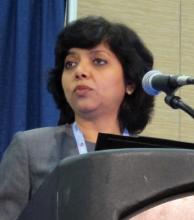BOSTON – Significant increases in bone density at the spine and hip were seen in adolescent girls with anorexia nervosa treated with physiological doses of estrogen, as compared with placebo, according to Dr. Madhusmita Misra, who presented the findings at the annual meeting of the Endocrine Society.
"We know that low bone mineral density is common in adolescent girls with anorexia nervosa. On dual-energy X-ray absorptiometry (DXA), about 50% have low z scores at one or more sites and they also have low bone accrual rates. This is a special concern during adolescence, when peak bone mass accrual normally occurs," said Dr. Misra, a pediatrician at Harvard Medical School and Massachusetts General Hospital in Boston.
While previous studies have shown that giving oral estrogen combined with progesterone as birth control pills is not effective at increasing bone density in these girls, the effect of giving estrogen in a more natural or physiologic form to mimic puberty or as a transdermal patch had not been studied before.
In a prospective, randomized study, 110 girls with anorexia nervosa and 40 normal-weight girls of similar pubertal stage and bone age between the ages of 12 and 19 years were enrolled. The girls with anorexia nervosa were randomized to receive either placebo or estrogen, but which type of estrogen they received depended upon their bone maturity based on wrist and hand x-rays. In order to avoid adversely affecting growth with estrogen, those with immature bone age (n = 14) received low-dose oral ethinyl estradiol in gradually increasing doses (3.75 mcg daily from 0-6 months, 7.5 mcg daily from 6-12 months, and 11.25 mcg daily from 12-18 months) while those with mature bone age (n = 96) received transdermal estradiol at full replacement doses (100 mcg 17-beta estradiol). All received calcium and vitamin D supplementation and were followed for 18 months (J. Bone Miner. Res. 2011 June 22 [doi.10.1002/jbmr.447]).
The results showed that after 18 months, spine and hip bone mineral density z scores increased significantly in girls with anorexia nervosa who received estrogen replacement, compared with those who received placebo, even after controlling for baseline age and weight.
Changes in lumbar bone mineral density were significantly lower at 6, 12, and 18 months in anorexic girls who did not receive estrogen, compared with either anorexic girls who received estrogen or healthy controls. No significant differences were seen in these measures between anorexic girls who received estrogen and healthy controls. Similar trends were seen for hip bone mineral density, with significant differences at all time points between non–estrogen-treated anorexic girls and healthy controls; differences between treated and untreated anorexic girls were significant only at 18 months.
The two anorexic groups did not differ in body mass index, fat mass, or lean mass after estrogen treatment, indicating that estrogen replacement does not cause weight gain or changes in body composition.
"This is very encouraging and exciting data," said Dr. Misra. "I would strongly emphasize that the first step in treating anorexia nervosa has to be to encourage weight gain and menses resumption. As we know, there may be many girls who are recalcitrant about formal treatment, and the adolescent years are a difficult time to accrue bone mass. This is a strategy to optimize bone accrual in girls with anorexia nervosa, even if they are not recovering otherwise." She added that it was important to note that estrogen replacement often falls short of complete restoration of bone density to normal levels.
Dr. Misra received support from Genentech.


